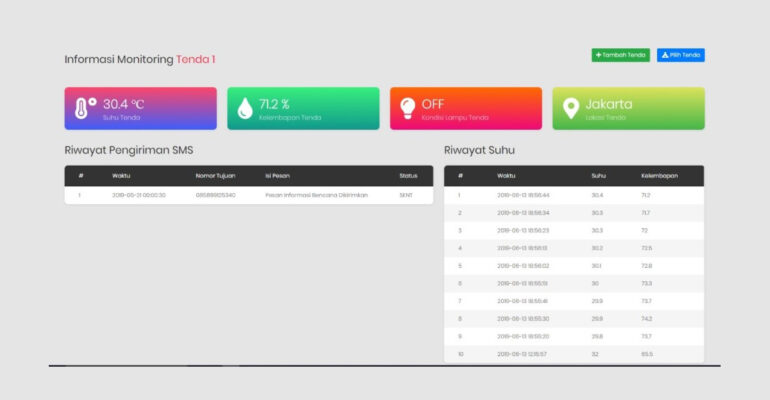IPB University Students Create Solar Emergency Smart Tents, Provide Electrical Energy in Disaster Sites

IPB University students created the Solar Panel Smart Emergency Tent (TEDAPIS) as a solution to provide electricity for victims of natural disasters. TEDAPIS is the work of students of the Department of Physics, Faculty of Mathematics and Natural Sciences (FMIPA), IPB University in the framework of the Student Creativity Program in the Field of Copyright (PKM-KC). The TEDAPIS team consists of Aldi Destia Lesmana as group leader, Astri Wahyuningtyas, Rohul Rizki Mubaroq Hartman. Under the guidance of Dr. Ir. Irzaman, M.Sc.
Aldi Destia Lesmana and the team made this work because they wanted to contribute to helping and providing relief for victims of natural disasters in Indonesia. This innovation is expected to facilitate and provide assistance quickly in emergencies for victims of natural disasters by creating a device that integrates smart devices. "Based on this, we need a new technology in emergency energy producers to use solar energy that is easily available to evacuee victims of natural disasters. So from that, a research on the design of refugee tents with integrated solar panels with smart devices was called "TEDAPIS (Smart Emergency Powered Solar Panel)," explained Aldi.
Aldi Destia Lesmana said that among the many easily available renewable energy sources, solar energy has the most promising potential. "Solar energy or solar energy is a source of energy that comes from sunlight that reaches the surface of the earth. The average energy received by the earth by the sun is: 3 X 1024 Joules a year or about 10 thousand times the world's energy consumption today. This makes the candidate's best solar energy source an energy source in disaster emergencies," Aldi said.
According to Aldi, the process of working electrical energy obtained by TEDAPIS comes from capturing sunlight through solar panels, namely direct current (DC) which will convert the current into alternating current 220 AC 50 Hez using an inverter so that it can be used to tent lighting needs, smart devices and the supply of electrical energy that will be stored in batteries as storage batteries. "The battery charging process will be controlled using a controller so there will be no excess in charging. Smart devices that are already connected to an electric current can immediately work to send assistance and communication to the contacts of the Regional Disaster Management Agency (BPBD), Search And Rescue (SAR), the Indonesian Red Cross (PMI) and the families that have been stored on the program server TEDAPIS and sent the coordinates of the location of the tent's establishment," Aldi said.
After a while the aid agency will receives the emergency message sent, the aid will immediately head to the location of the tent's establishment to provide relief. In addition to asking for help from outside parties, said Aldi, the victims were able to monitor the temperature and humidity of the tents with temperature and humidity sensors that could also be monitored by the central command post to immediately provide assistance when the tent room temperature was low.
TEDAPIS lighting can be run automatically because of the light sensor connected to the two channel relay as a controller on the lamp. The performance of smart devices can be monitored through a website that can be accessed via a smartphone using a local Wifi network that is connected to the Raspberry Pi 3 as a server.
The website on TEDAPIS can be used to send messages to outsiders, see messages from the help, history of temperature and humidity, monitor the conditions for each tent and see the condition of the lights for lighting.
The TEDAPIS device is equipped with a brief guidebook on how to install tents and electronics. "The iron frame and tarpaulin on the TEDAPIS are modified, to facilitate the installation process such as the presence of certain marks and identification codes in each iron bar. The process of assembling iron which is connected, and hook and iron material is relatively lighter than the usual refugee tents. The tarpaulin on TEDAPIS can be installed by pairing it directly without confusion giving a lot of stakes. The electronic device on TEDAPIS has been placed in a special bag in one place so there is no need to move the electronic device, the electronic device can be assembled in a TEDAPIS bag and connected to another TEDAPIS device. The smart device that was made was also placed in a small portable black box that was placed in a TEDAPIS bag as well. The process of installing TEDAPIS can be done 1-2 people," Aldi explained.
After a while the aid agency receives an emergency message sent, the aid will immediately head to the location of the tent's establishment to provide relief. In addition to asking for help from outside parties, said Aldi, the victims were able to monitor the temperature and humidity of the tents with temperature and humidity sensors that could also be monitored by the central command post to immediately provide assistance when the tent room temperature was low.
TEDAPIS lighting can be run automatically because of the light sensor connected to the two channel relay as a controller on the lamp. The performance of smart devices can be monitored through a website that can be accessed via a smartphone using a local WiFi network that is connected to the Raspberry Pi 3 as a server.
The website on TEDAPIS can be used to send messages to outsiders, see messages from the help, history of temperature and humidity, monitor the conditions for each tent and see the condition of the lights for lighting.
This TEDAPIS advantage can obtain electrical energy from solar panels for lighting, smart devices, electricity supply for some electronic devices. Smart devices that can be used to send messages and coordinate locations for the establishment of emergency tents to the Regional Disaster Management Agency (BPBD), Search and Rescue (SAR), the Indonesian Red Cross (PMI). In addition, information on the condition of family health, see the temperature and humidity in the tent, turn on the lights automatically with the help of a light sensor to read the lighting conditions outside the tent. (dh / ris)



